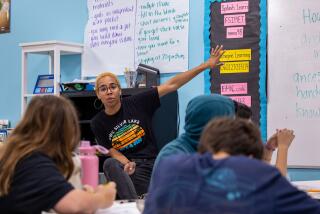Of Mice and Math : Animals in This Classroom Aren’t Just Cute, They’re Also a Vital Part of the Curriculum
- Share via
When sixth-grade teacher Barbara Graham wants to teach students about the fragile ecology of the rain forest, Wanna the Iguana helps her make the point.
If the topic is genetics, she asks students to predict the coloring of the offspring of Ratty and his albino mate.
And Graham has discovered that children who have done poorly on math tests can benefit by writing letters to Mr. Piggy, explaining what they did wrong in language clear enough for a guinea pig to understand.
Wanna, Ratty and Mr. Piggy are among the dozens of small creatures in Graham’s menagerie at Pennekamp Elementary School in Manhattan Beach. The animals, which also include mice, hamsters and fire-bellied toads, are not just there for display; they serve as prized teaching aids for Graham’s lessons in writing, science and math.
“Animals are part of many elementary classrooms, and very often they sit in a corner and look cute and kids pet them and maybe take them home,” Graham said. “But in my classroom, they are an active part of my curriculum. They are intimately involved in the curriculum as teachers and learners.”
For four years, Graham has led seminars for aspiring teachers at UCLA and USC on incorporating animals into classroom lessons. She speaks about her “animal laboratory” at three math council meetings every year and recently wrote about her teaching techniques for the California Assn. for the Gifted.
“We’re just really proud to have her in our district,” Manhattan Beach City School District Supt. Jerry Davis said. “(Her teaching methods) are very visual and the kids love it.”
Graham, a teacher since 1970, incorporates the animals in a variety of lessons, although she is adamant that no animal in her class ever be harmed.
“I tell the kids that in other rooms you might be doing dissections, but in this room you will learn to love and respect them,” Graham said. “You will never do anything to hurt them in any way in my classroom.”
Graham uses the animals as living teaching aids in lessons organized around themes, not subjects--an instructional method considered cutting-edge among many educators.
The technique was evident earlier this week during a full day of class in Room 3, where Graham teaches two sections of science and literature and one section of math.
Students and dozens of small animals share the large and cheerful classroom, which is cluttered with neatly arranged books, student-drawn pictures and writing assignments. Many students reach into the cages before class starts to pet some of animals but they quickly settle down when Graham wants to get started.
She begins the day by asking students to share word problems they wrote last week. Almost all of the problems, including one by 12-year-old Jonathan Mossberg, involve classroom creatures.
“One mother frog had some babies and six more were born the next year. Now there are a total number of 12. How many frogs were born the first year?” Mossberg asks his classmates. He then solves the problem on an overhead projector.
Later, Graham introduces a topic on genetics, using a pair of rats.
Two students hold the rats, an albino female and a dark colored male, at the front of the class while Graham goes around the room asking students to describe the rats’ characteristics. They discuss how some genes are dominant and others are recessive, and how some dark rats carry a gene that produces albino babies.
As a math exercise, students predict what percentage of the rats’ offspring will be albino and what percentage will be dark. When the babies are born in two months, students will check their predictions and talk about the birth cycle of rodents.
“Kids have a love affair with animals,” Graham said later. “It’s kind of an international thing. I have never had a kid in eight years who didn’t want to be with the animals.”
The animal classroom, however, can have its traumatic side. Graham and the children once discovered that a hamster had eaten most of her babies. But nothing hurt as much as the death of Patches in November, 1990.
Graham still becomes emotional when she talks about Patches, a beloved black-and-white guinea pig that had been “weighed and measured so many times in her life that she wouldn’t move” when you put her on the scale, Graham said.
When Graham discovered that Patches had died, she wrapped her in a towel and placed her in a shoe box at the front of the classroom. She and the students talked about death, “how it’s a natural process and how hard it is to lose a friend,” Graham said.
Later that night, she took Patches home and buried her in the flower garden.
“The kids were very sad, but I think they were more worried about me because I had her for five years,” Graham said.
Today, Graham’s classroom is home to four guinea pigs, three mice, four hamsters, five rats, seven fire-bellied toads, one tree frog, a tadpole and an iguana.
Although Graham pays for some of the costs of their care out of her own pocket, the Manhattan Beach Education Foundation and the Parent-Teacher Assn. together donate $2,100 a year to pay for the animals’ upkeep. Students also raise money for them by participating in recycling drives.
“(Graham) makes a difference in every child’s life in that classroom,” said Tracey Windes, a parent and secretary of the Manhattan Beach Education Foundation. “She’s remarkable, and she makes sure every child is touched by those animals.”
Ten-year-old Katie Dockings, who sits at the back of the room next to Wanna the Iguana, is a case in point.
“Before I came here, I had never really heard of a guinea pig,” Katie said. “But Mrs. Graham makes it seem interesting. Instead of just having the animals here to look at, she uses math with the animals, like when we’re using decimals and fractions.
“I feel it’s kind of neat that she can have all these animals in the class,” she added. “It makes the class a lot more fun.”
More to Read
Sign up for Essential California
The most important California stories and recommendations in your inbox every morning.
You may occasionally receive promotional content from the Los Angeles Times.










